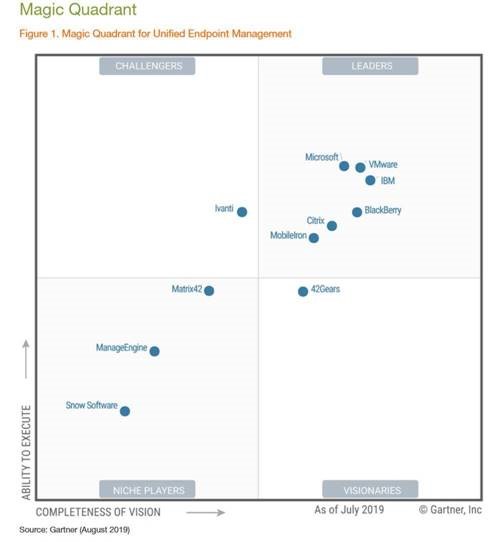
Microsoft is a leader in the Gartner Magic Quadrant for Unified Endpoint Management, 2019
Gartner, Magic Quadrant for Unified Endpoint Management Tools, Chris Silva, Manjunath Bhat, Rich Doheny, Rob Smith—August 6, 2019.
Earlier this month, Gartner published their 2019 Magic Quadrant (MQ) for Unified Endpoint Management.
Just like last year, Gartner has positioned Microsoft in the Leaders Quadrant in the “2019 Magic Quadrant for Unified Endpoint Management (UEM) Tools, Worldwide,” based on its completeness of vision and ability to execute in the UEM market.” Microsoft is also highest in the “Ability to Execute” axis.
That’s good news, but, like any subjective measurement, the most important part of any UEM product is how it impacts the organizations who use it. When I meet with customers, nearly all of them seem to embrace three of the strengths called out by Gartner in the report:
- Extensive integration across products exposes capabilities that are difficult to replicate piecemeal.
- Exclusive integration with System Center Configuration Manager (ConfigMgr), and incremental migration capabilities for PCs to Microsoft Intune and ConfigMgr co-management can reduce the complexity of the transition to UEM.
- Full integration with Office 365 mobile apps.
Whenever you study the placements within an MQ, it’s always interesting to consider what trends and market forces were driving the ultimate conclusions made by Gartner. For example, there’s no longer any doubt that complete endpoint management has to be inclusive of on-premises tools and processes to manage PCs. This is a point of view we’ve championed for years, and it’s the reason why we’ve pursued a unified solution that seamlessly attaches cloud capabilities to existing PC management infrastructure. It’s really exciting to see so many others in the community responding to this customer need.
Perhaps the most helpful way to look at all of this is to determine for yourself what a “modern workplace” looks like and what it means for your organization to modernize. In my opinion, the thing that makes a management tool “modern” is whether its insights and intelligence have cloud scale and cloud connection. This type of connection not only offers more control and insight to the IT teams using the tool, but it also allows the tool to be improved and refined in ways that were not possible in the past. This perspective guides every decision my team makes when we’re investing in and engineering Intune and ConfigMgr. This type of endpoint management benefits every person using it—even organizations that aren’t yet ready for a complete shift to cloud-based management.
I have written a lot about how seriously Microsoft emphasizes “customer-obsession” at every stage of our engineering process, but now the positive effects of this emphasis have moved beyond our company. Over the past year, multiple UEM vendors have announced integrations with Intune and ConfigMgr so their customers can also benefit from Microsoft 365. The Gartner report goes so far as to note that the integration work done by these other vendors is a “key benefit” in their positive ranking within the MQ. I think it’s awesome that Intune is not only a ubiquitous standalone solution but is also now used as a platform.
I am very proud of the work we’ve done with these vendors. Right now, we have a great partnership with the Android Enterprise team at Google, where we are one of the first partners to build on top of their advanced cloud management architecture, and the breadth and depth of our support for Apple’s macOS and iOS continues to grow.
Since most organizations already use ConfigMgr for their PC management, Intune (and, more importantly, Microsoft 365) is the ideal solution for most organizations. I recently announced that ConfigMgr and Intune are managing more than 175 million Windows, Mac, iOS, and Android devices—making it, by far, the most widely used endpoint management solution. And that number grows by one million each week!
The reason why this growth is so important to you is that those 175 million endpoints bring back the most complete and authoritative data set on enterprise devices—and the things we learn from that much signal gives us the insight necessary to build the tools and features you need. That’s the beauty of modern management: Learning at cloud-scale and then personalizing and applying what we learn to every organization—no matter how small or how big. This is uniquely a Microsoft 365 capability, and it’s awesome.
As you continue to plan for the needs of your organization and the demands on your infrastructure, please let us know how we can support the work you’re doing with Microsoft 365 by reaching out to your account team.
You can read the full report.
This graphic was published by Gartner, Inc. as part of a larger research document and should be evaluated in the context of the entire document. The Gartner document is available upon request from Microsoft.
Gartner does not endorse any vendor, product or service depicted in its research publications, and does not advise technology users to select only those vendors with the highest ratings or other designation. Gartner research publications consist of the opinions of Gartner’s research organization and should not be construed as statements of fact. Gartner disclaims all warranties, expressed or implied, with respect to this research, including any warranties of merchantability or fitness for a particular purpose.





